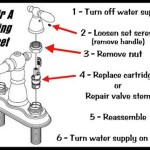Bathroom Faucet Hard To Turn
A stiff or hard-to-turn bathroom faucet can be a frustrating inconvenience. This issue can range from a slight resistance to a complete inability to operate the handle. Understanding the potential causes can help homeowners troubleshoot the problem and determine the best course of action, whether it involves a simple DIY fix or calling a professional plumber.
One of the most common culprits behind a difficult-to-turn faucet is mineral buildup. Hard water contains dissolved minerals like calcium and magnesium. Over time, these minerals can deposit on the internal components of the faucet, particularly the cartridge or valve stem. These deposits restrict movement and make it harder to turn the handle. The severity of the buildup depends on the hardness of the water supply and the age of the faucet.
Corrosion can also contribute to a stiff faucet handle. While less common than mineral buildup, corrosion can affect the metal components within the faucet, especially in older fixtures. Rust and other forms of corrosion can create friction and impede the smooth operation of the handle. This is particularly true in areas with high humidity or where the water supply is slightly acidic.
A worn-out O-ring can also make a faucet handle difficult to operate. O-rings are small rubber seals that help prevent leaks and ensure smooth handle movement. Over time, these rings can become dry, cracked, or compressed, losing their elasticity and effectiveness. This can lead to increased friction and make the handle harder to turn. Replacing O-rings is a relatively simple and inexpensive repair.
A more complex issue could lie within the faucet cartridge. The cartridge is a crucial component that controls the flow and temperature of the water. A worn, damaged, or corroded cartridge can significantly restrict handle movement. Depending on the faucet model, replacing a cartridge can be a moderate DIY project or may require the expertise of a plumber.
Another potential cause of a stiff faucet handle is a problem with the valve seat. The valve seat is the surface against which the valve closes to stop the flow of water. If the valve seat becomes corroded or damaged, it can interfere with the smooth operation of the handle. Repairing or replacing a valve seat typically requires disassembling the faucet.
In some cases, the packing nut can be over-tightened. The packing nut helps secure the handle and stem assembly. If this nut is tightened too much, it can compress the packing material and restrict handle movement. Loosening the packing nut slightly can often resolve this issue.
Incorrect installation can also lead to a stiff faucet handle. If the faucet wasn't installed properly initially, various components might not align correctly, causing friction and making the handle difficult to turn. This highlights the importance of proper installation by a qualified professional or a careful adherence to manufacturer instructions for DIY installations.
Troubleshooting a stiff faucet handle often begins with identifying the type of faucet. Two common types are ball-type faucets and cartridge faucets. Each type has a different internal mechanism, and understanding the specific type can guide the troubleshooting process. Consulting the manufacturer's documentation or searching online for information based on the faucet model can be helpful.
Before attempting any repairs, it's crucial to turn off the water supply to the faucet. This typically involves closing the shut-off valves located under the sink. Once the water supply is off, the faucet handle can be removed to inspect the internal components. Depending on the issue, simple solutions like cleaning mineral deposits or replacing O-rings might suffice. However, more complex problems, like a damaged cartridge or valve seat, might necessitate professional assistance.
Regular maintenance can prevent many of the issues that lead to a hard-to-turn faucet. Periodically cleaning the faucet aerator can help prevent mineral buildup. Inspecting and replacing worn O-rings can also prevent stiffness. If the water supply is particularly hard, installing a water softener can significantly reduce mineral deposits and prolong the life of the faucet.
Choosing high-quality faucets made from durable materials can also contribute to long-term performance and reduce the likelihood of issues like corrosion and premature wear. While the initial cost might be higher, investing in a quality faucet can save money and frustration in the long run by minimizing the need for repairs and replacements.

Stuck Or Hard To Turn Pfister Faucet Handle Easy 0 Repair

Faucet Handle Hard To Turn

Bathroom Faucet Handle Sticking And Hard To Turn Easy Fix Delta

Bathroom Handle Stiff Or Difficult To Operate

Grohe Faucet Handle Keeps Moving The Wrong Way

Pfister Faucet Super Hard To Turn On

Fixing Hard To Turn Shower Faucet Handle

How To Remove A Stuck Frozen Tight Hard Turn Pfister Bathroom Faucet Handle

How To Fix A Hard Turn Bathroom Faucet Handle

Bathroom Handle Stiff Or Difficult To Operate







